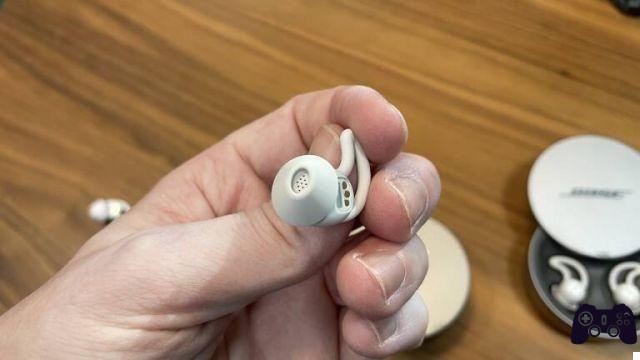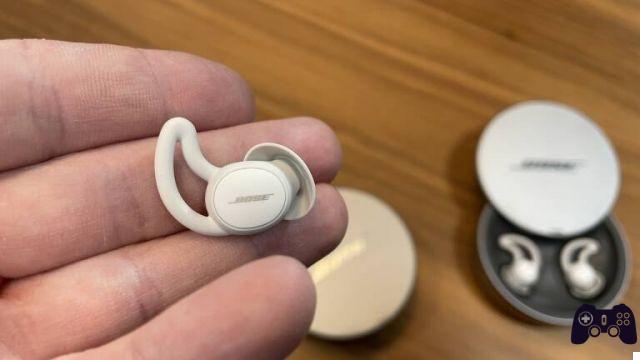When Bose introduced the sleepbuds, you put very high expectations on that product, as probably any other person who has sleep problems. The experience with the first sleepbuds was half convincing, simply because they had all the credentials to do their duty, that is to mask the background noises that can disturb during the night, but took a long time to get used to sleeping with a pair of earphones inserted in the ears.

Unfortunately, the first sleepbuds suffered from a youth problem that led Bose to carry out a product recall, resulting in a reimbursement of the expense. Several months after the presentation, after a software update, the earphones no longer recharged to 100% and the autonomy was reduced to a few hours.
Bose then tries again with the Sleepbuds 2, taking the opportunity to improve the product from other points of view.
How they are made
Aesthetically, the differences compared to the first sleepbuds are minimal, after all on such a small product the room for maneuver is reduced. The case is always circular, with the lid that opens thanks to a mechanism that slides it back to detect the housing of the earphones, five LEDs that indicate the state of charge of the battery of the case and two additional LED indicators that will tell us if the earphones have been inserted correctly and the battery is charging. A USB-C port on the back allows you to recharge the case.

Physically, the earphones take up the same footprint as the first model, but are flatter. The difference is probably just under 1 millimeter, but it makes itself felt, especially when you rest your ear against the pillow.
Bose has specified that the new Sleepbuds 2 have a better antenna, which allows a more stable connection with the smartphone, and obviously a battery that will avoid the problems found on the first model.

The application, simple and effective
The application is always the same as the first version, improved from an aesthetic point of view. The interactions it offers are limited to connecting the earphones, checking the battery status, setting the alarm and choosing the sound to play.
How do they work
Sleepbuds don't use Active Noise Reduction to filter out external noise, and the reason is simple: it wouldn't work. The ANC earphones use microphones to detect sounds and send them, in counterphase, inside the earphone, to cancel the sound waves. Microphones take up space, and multiple microphones are often required to achieve good ANC performance. Furthermore, this technology requires energy to operate, much more power than the tiny battery inside the sleepbuds can deliver.

Moreover, the ANC technology changes its effectiveness according to the type of noise (frequency) it wants to reduce, and the risk would therefore be to be able to filter only some noises.
The sleepbuds therefore use a “noise masking” solution, a difficult way to describe the continuous playback of a sound loud enough that you cannot hear other external sounds.
You can choose the sound to be reproduced from a series of natural sounds, melodies or pink or white noises. Each sound has such a cyclical nature that it soon becomes so repetitive that your brain will quickly begin to "ignore" it, allowing you to fall asleep, thus avoiding that it is this sound that disturbs your sleep. At first glance it seems a contradiction, but we assure you that it works just as we have described it.
Experience of use
One of the improvements made concerns the earphone housing, which now offers insertion precision and a firmer magnetic grip than the first version. It happened, with the first Sleepbuds, not to fit them perfectly in the case and end up with the headset discharged in time of need, while with the Sleepbuds 2 we never had any problems.
The insertion inside the ear is no different than the first version, and that's good: they fit easily, just a slight rotation to position them and they stay firm all night. In about a month of testing we only happened to lose a headset once.

They remain perfectly inside the ear and you can sleep even with your ear resting on the pillow, without problems.
Once again, however, we must remember that the time needed to get used to it is not immediate, and based on personal sensitivity, one night may be enough, or you may never get used to it. Earphones, in general, are very personal devices, and sleepbuds are extremely personal, as most people, even those with very sensitive ears, can endure earphones for a few hours, but in this case we are talking about a tolerance that it must last all night while you sleep.


Autonomy
The Sleepbuds 2 provide up to ten hours of battery life, and the case allows you to recharge them about three times, allowing you to have up to four nights of battery life.

The competition
The competition is represented solely by the Amazfit Zenbuds, which we have reviewed here: Amazfit Zenbuds, noise-masking earphones for sleeping.
Verdict
The Sleepbuds 2 do their homework well, and they do it even better than the first version. It is difficult to make a comparison, especially due to the battery problem and the recall campaign of the first model. We can tell you that if, like me, you were the owner of the first sleepbuds and cried bitter tears when you encountered the battery problems, you should buy the new sleepbuds 2 without waiting a minute longer.
If, on the other hand, it is the first time you approach this product and you are looking for a solution against the neighbor who wakes you up at three in the morning, then you should give the Sleepbuds 2 a try. If you are lucky, then your body will quickly get used to sleeping with. a pair of earphones in the ears that play a continuous noise, then you will be happy with the purchase. If not, luckily there is the possibility of returning an item that you are not satisfied with.

If you want to save money and have a similar product, you could also opt for the Amazfit Zenbuds, however you will be buying a product that brings with it all the features of a "cheap" product, so a slightly worse wearability, a rougher application, a more limited total autonomy and a less refined case.












